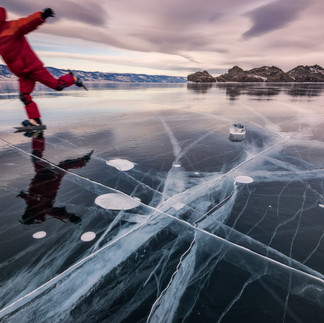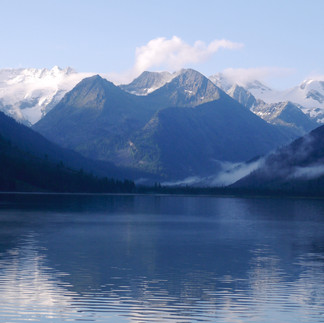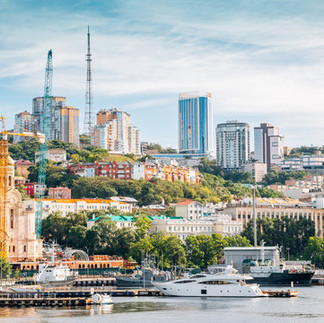Best places to visit in Siberia in 2022
- Alex

- Apr 6, 2022
- 5 min read
Updated: Jun 23, 2022
In Siberia, there are many amazing places that offer incredible experiences. You can enjoy breathtaking nature, immerse in the local culture, get lost in the charming streets of an ancient town, and live once-in-a-lifetime adventures. Here are the top places to visit in Siberia in 2022.

Lake Baikal
As the planet’s oldest, deepest and purest lake of fresh water, Baikal is one of the most popular landmarks in Russia. You can have various kinds of experiences there: from lying on the beach to taking a boat to the sacred Olkhon island or a train ride along the shore to making delicious campfire coffee.
Baikal is beautiful in all seasons: in summer, you can sunbathe and swim in the crystal clear waters of the lake, while in winter, from mid-January to late March, the lake freezes over, so its entire surface is covered with see-through ice up to two meters thick. Travelers can cross the lake on foot, on skates, or even by car. Early March, Lake Baikal hosts the world’s unique marathon on ice.
Irkutsk
A short distance from Lake Baikal is the historical town of Irkutsk. With about half a million people and over 360 years of history, Irkutsk is visited by over a million tourists yearly. Many of them come to the town on their way to Lake Baikal or make a stop on their Trans-Siberian journey. There, you can see intricate wooden architecture, visit a monastery and numerous churches, take a river cruise, and much more.
Altai Mountains
No Russia’s sightseeing list is complete without the majestic Altai Mountains and a charmingly turquoise Katun river passing through them. You can camp on the riverside or close to one of the numerous lakes, do rafting or ride a horse.
Novosibirsk
Novosibirsk, the so-called capital of Siberia, is situated in the middle of Siberia and is an important hub from which you can travel almost anywhere in Russia. The city is also known as a cultural center, with world-famous ballet, theatres and operas. Right next to Novosibirsk lies Academgorodok, Russia’s Silicon Valley, with dozens of research centers.
Tomskaya Pisanitsa
The Tomskaya Pisanitsa Museum is situated on the bank of the Tom River in Western Siberia and is known for its 280 petroglyphs dating from 4000–1000 BC. It all started with the discovery of ancient drawings on the coastal rocks in the 16th-17th centuries, which gave the place its name - Pisanitsa, from the verb pisat’ (to write). However, the restoration and preservation of the rock paintings started only in the 70-and 80s of the last century. Today, Tomskaya Pisanitsa is an open-air museum, where you can learn about Siberia’s indigenous people.
A short distance off is the town of Tomsk, famous for its wooden architecture and also known as Siberian Athens due to a large number of universities.
Plateau Putorana
Plateau Putorana is a mountainous area to the northwest of Siberia, which occupies territory comparable to the territory of the UK. Plateau Putorana is famous for its deep canyons and hundreds of waterfalls and lakes. Situated above the Arctic Circle, it is one of the most remote areas on Earth for tourism. Temperatures vary from 10°C in summer to −35 °C in winter, which lasts for the better part of a year. Nature is very diverse: from taiga and tundra to glaciers on the top of the mountain. Apart from enjoying breathtaking views, tourists can also explore activities like rafting in the river, fishing in lales and many more.
Sources: Wikipedia, Windows10Spotlight, World Meros
Chara Sands
Siberia is not only about snow and mountains, you can also see an actual desert here. These picturesque sand dunes are located in Zabaykalsky Krai. They look pretty spectacular in the background of snow-capped mountain peaks. The sand dunes occupy the territory of about 3,000 ha, and some of them are 80 meters high! The only difference with southern deserts is that instead of camels, you’ll see reindeer caravans.
The best time to visit the place is midsummer when it’s usually hot enough, so you can actually feel you’re in a real desert. Travelers can sunbathe on the dunes and swim in a nearby lake. If you decide to camp, better do it by the lake. Spring is also a great time for visiting Chara Sands, as the dunes are covered with flower carpets.
Sources: Vpoxod.ru, Wikipoints.ru, kp.ru
Lena Pillars
Along the banks of a great and powerful Lena river there is one more Siberian nature wonder that will amaze anyone who dares to go that far. Lena stone pillars are mysterious rock formations that once were the ocean floor and are now a very unusual sight that is now reminiscent of its distant past. The best way to witness all the beauty of the place is to take a boat down the river: you’ll see miles of unique stone pillars 150 to 300 meters high. Bus you can enhance the experience even more by climbing to the top of the Lena pillars and enjoy breathtaking views over the river.
Sources: Wikipedia, Orange Smile, Wikimedia
Siberian Waterfalls
In Siberia, there are also many places where you can enjoy the view over waterfalls or even swim in one. Here are three waterfalls you might want to see:
Corbu Waterfall, Altai Republic. Corbu is one of Siberia's most spectacular and popular waterfalls. It’s 12.5 m high. The road to the waterfall lies through Teletskoye Lake and delights the eye just as much.
Shinok Waterfalls, Altai Region. Waterfalls on the Shinok River amaze tourists throughout the year: in summer, travelers can swim in the purest water of the river, while in winter the waterfalls completely freeze and turn into a fabulous ice sculpture. The cascade is the largest in the Altai in terms of the waterfall height and number.
Kandinsky Waterfall, Plateau Putorana. Plateau, known as an area of a thousand lakes and a thousand waterfalls, is one of the most hard-to-reach travel destinations on the planet. However, it has a lot to offer to a well-prepared traveler, for example, in the most remote area of the plateau, one can see Kandinsky Waterfall. Its largest direct fall is 108 m high and is considered to be the highest in Russia.
The Great Arctic Nature Reserve
If you are willing to take an adventure route up north, be sure to visit the Great Arctic Nature Reserve, a vast desert with icebergs and polar bears, which also happens to be the largest nature reserve in Eurasia. It occupies more than 4mn ha and stretches for over 1,000 km west to east and over 600 km north to south. The reserve was founded with a goal to help travelers explore the northern parts of the Earth and see the Arctic Ocean with their own eyes. The territory of the reserve is populated with walruses, white whales, seals, polar bears, reindeer and other northern species. Tourists can also do rafting, spearfishing and polar driving along the coast of the Arctic Ocean.
Sources: arctic.ru, russian-travels.ru, pikabu.ru
Vladivostok
Vladivostok is a city in the Far East of Russia, known as the Russian San Francisco due to its Pacific location and hilly streets offering spectacular views over the city and the ocean. The name of the city derives from two words - “possess” and “East” and is reminiscent of the Russian expansion to the East. It is a very important port for Russian trade, through which many goods from Japan and other neighboring countries enter the Russian market. The city is very modern, with new buildings and bridges built every year, and it also hosts world-class events, such as Eastern Economic Forum, and more. In summer, temperatures reach 20°C, while in winter it rarely goes below -15°C. August is the warmest month throughout the year.
Sources: Adobe, Livejournal
Kuril Islands
Kuril Islands, or the Kurilskiye Ostrova, are an archipelago consisting of 56 islands and extending from Kamchatka to the north of Japan. Kuril Islands are known for active volcanoes, amazingly beautiful natural reserves and untouched nature. The trip to Kuril Islands is not the easiest one, as you can only get there by boat, but definitely worth it.
Sources: Wikipedia, TripAdvisor (contriputers)











































































Comments